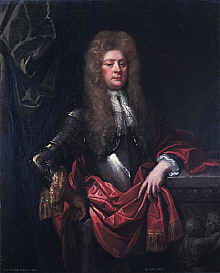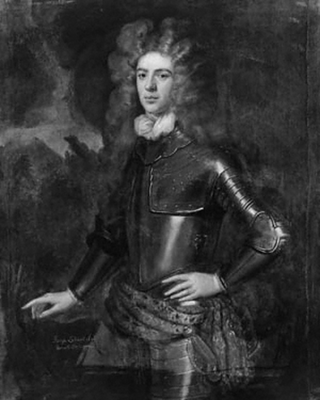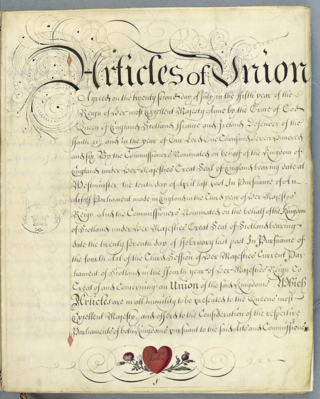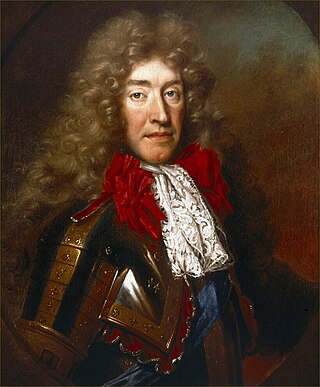
The Acts of Union were two Acts of Parliament: the Union with Scotland Act 1706 passed by the Parliament of England, and the Union with England Act 1707 passed by the Parliament of Scotland. They put into effect the terms of the Treaty of Union that had been agreed on 22 July 1706, following negotiation between commissioners representing the parliaments of the two countries. By the two Acts, the Kingdom of England and the Kingdom of Scotland—which at the time were separate states with separate legislatures, but with the same monarch—were, in the words of the Treaty, "United into One Kingdom by the Name of Great Britain".

John Dalrymple, 1st Earl of Stair PC was a Scottish politician and lawyer. As Joint Secretary of State in Scotland 1691–1695, he played a key role in suppressing the 1689-1692 Jacobite Rising and was forced to resign in 1695 for his part in the Massacre of Glencoe. Restored to favour under Queen Anne in 1702 and made Earl of Stair in 1703, he was closely involved in negotiations over the 1707 Acts of Union that created the Kingdom of Great Britain but died on 8 January 1707, several months before the Act became law.
The Nonjuring schism refers to a split in the established churches of England, Scotland and Ireland, following the deposition and exile of James II and VII in the 1688 Glorious Revolution. As a condition of office, clergy were required to swear allegiance to the ruling monarch; for various reasons, some refused to take the oath to his successors William III and II and Mary II. These individuals were referred to as Non-juring, from the Latin verb iūrō, or jūrō, meaning "to swear an oath".

The Parliament of Scotland was the legislature of the Kingdom of Scotland from the 13th century until 1707. The parliament evolved during the early 13th century from the king's council of bishops and earls, with the first identifiable parliament being held in 1235 during the reign of Alexander II, when it already possessed a political and judicial role.

James Douglas, 2nd Duke of Queensberry and 1st Duke of Dover was a Scottish nobleman and a leading politician of the late 17th and the early 18th centuries. As Lord High Commissioner he was instrumental in negotiating and passing the Acts of Union 1707 with England, which created the Kingdom of Great Britain.

Sir George Lockhart of Lee, of Carnwath, South Lanarkshire, also known as Lockhart of Carnwath, was a Scottish writer and Jacobite politician who sat in the Parliament of Scotland from 1702 to 1707 and as a Tory in the House of Commons from 1708 to 1715. He was a member of the Commission on the Union before 1707 but acted as an informant to his Jacobite colleagues and later wrote an anonymous memoir of its dealings. He supported the Stuart cause in the Jacobite rising.

William Nicolson (1655–1727) was an English churchman, linguist and antiquarian. As a bishop he played a significant part in the House of Lords during the reign of Queen Anne, and left a diary that is an important source for the politics of his times. He was a versatile scholar, involved in numerous collaborations and contributing uncredited in the work of others.

The Treaty of Union is the name usually now given to the treaty which led to the creation of the new state of Great Britain, providing that the Kingdom of England and the Kingdom of Scotland were to be "United into One Kingdom by the Name of Great Britain". At the time it was more often referred to as the Articles of Union.
Duncan Forbes of Culloden (1644–1704) was a politician and member of the Parliament of Scotland between 1678 and 1704. He was a strong supporter of Whiggism, a political philosophy developed during the 1638 to 1651 Wars of the Three Kingdoms, which advocated the supremacy of Parliament over the monarch and opposed Catholicism.

The Restoration was the return of the monarchy to Scotland in 1660 after the period of the Commonwealth, and the subsequent three decades of Scottish history until the Revolution and Convention of Estates of 1689. It was part of a wider Restoration in the British Isles that included the return of the Stuart dynasty to the thrones of England and Ireland in the person of Charles II.
After the conclusion of the 1698 English general election the government led by the Whig Junto believed it had held its ground against the opposition. Over the previous few years, divisions had emerged within the Whig party between the 'court' supporters of the junto and the 'country' faction, who disliked the royal prerogative, were concerned about governmental corruption, and opposed a standing army. Some contests were therefore between candidates representing 'court' and 'country', rather than Whig and Tory. The Whigs made gains in the counties and in small boroughs, but not in the larger urban constituencies. After Parliament was dissolved on 7 July 1698, voting began on 19 July 1698 and continued until 10 August, with an order directing the new House of Commons to meet on 24 August 1698.

The Glorious Revolution in Scotland refers to the Scottish element of the 1688 Glorious Revolution, in which James VII was replaced by his daughter Mary II and her husband William II as joint monarchs of Scotland and England. Prior to 1707, the two kingdoms shared a common monarch but were separate legal entities, so decisions in one did not bind the other. In both countries, the Revolution confirmed the primacy of Parliament over the Crown, while the Church of Scotland was re-established as a Presbyterian rather than Episcopalian polity.

Sir James Murray, Lord Philiphaugh PC was a Scottish judge and politician who twice served as Lord Clerk Register from November 1702 to June 1704 and from April 1705 to July 1708, when he died in office. Serving as a political advisor to prominent statesman James Douglas, 2nd Duke of Queensberry, Murray assisted him in passing the 1707 Union with England Act through a divided Parliament of Scotland.
Sir Gilbert Eliott, 3rd Baronet, of Stobs was a Scottish Whig politician who sat in the British House of Commons between 1708 and 1727. He was outlawed after killing his opponent in an after-dinner argument and fight, but was subsequently pardoned.
Sir John Johnstone, 1st Baronet was a Scottish Army officer and politician.
Before the Acts of Union 1707, the barons of the shire of Linlithgow elected commissioners to represent them in the unicameral Parliament of Scotland and in the Convention of the Estates.
John Montgomerie, of Wrae, Linlithgow, was a Scottish businessman, customs farmer and Whig politician who sat in the Parliament of Scotland from 1704 to 1707, and in the British House of Commons briefly in 1710.
The Honourable James Campbell of Burnbank and Boquhan was a Scottish nobleman of Clan Campbell. He was an officer of the Royal Scots Army and then the British Army, and a politician who sat in the Parliament of Scotland from 1699 to 1702 and as a Whig in the British House of Commons from 1708 to 1710.
John Pringle, Lord Haining was a Scottish lawyer, politician, and judge. His ownership of a large estate near Selkirk secured him a seat in the Parliament of Scotland from 1702 until the Act of Union in 1707, and then in the House of Commons of Great Britain from 1707 until he became a Lord of Session in 1729.
Sir Patrick Johnston (1650–1736) of Edinburgh was a Scottish merchant and politician who sat in the Parliament of Scotland from 1702 to 1707 and as a Whig in the British House of Commons between 1707 and 1713. He was Lord Provost of Edinburgh three times from 1700 to 1702, from 1704 to 1706, and from 1708 to 1710.












